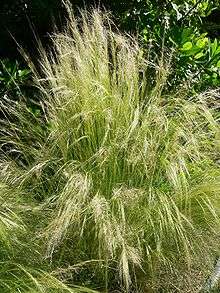Nassella tenuissima
Nassella tenuissima is a species of grass known by the common names Mexican feathergrass,[2] finestem needlegrass,[3] fineleaved nassella,[4] and Argentine needle-grass.[5] It is native to the south-western United States, northern Mexico[4] and Argentina.[5] It is well-matched to climate in Australia and can be harmful to the Australian environment.[6]
| Nassella tenuissima | |
|---|---|
 | |
| Scientific classification | |
| Kingdom: | Plantae |
| Clade: | Tracheophytes |
| Clade: | Angiosperms |
| Clade: | Monocots |
| Clade: | Commelinids |
| Order: | Poales |
| Family: | Poaceae |
| Subfamily: | Pooideae |
| Genus: | Nassella |
| Species: | N. tenuissima |
| Binomial name | |
| Nassella tenuissima (Trin.) Barkworth | |
| Synonyms[1] | |
| |
It is sometimes used as an ornamental garden plant, but readily escapes, and has become naturalized in the San Francisco area.[4] The availability of N. tenuissima via the internet and other plant purchasing situations makes its entry and naturalization in Australia almost inevitable.[2]
It is similar in appearance to Nassella trichotoma (serrated tussock) and has been recorded in Australia as a weed initially mistaken for that other invasive species.[7]
Impacts
N. tenuissima has been described by weed experts as a potential 'disaster for the Australian environment'.[2] In Australia, it is considered a major threat to eucalypt woodlands and native grasslands, with government modelling indicating that up to 169 million hectares could be at risk.[8]
N. tenuissima is also likely to have significant impacts on beef and wool production. It is closely related to serrated tussock (N. trichotoma) and Chilean needle grass (N. neesiana), both designated Weeds of National Significance because they displace pasture grasses and produce seeds that contaminate wool.[8] Serrated tussock, which is estimated to cost NSW agriculture more than $40 million annually,[9] is said to be causing a greater reduction in pasture carrying capacity than any other weed in Australia, yet N. tenuissima is thought to be capable of occupying 6 times the area predicted for Serrated tussock.[6]
Pathways
It is illegal to import N. tenuissima into Australia but it has been imported as a nursery plant under incorrect or outdated names. For example, in 2009 a nursery imported N. tenuissima seeds by incorrectly labelling them as Stipa lessingiana, which is a permitted import.[10] A similar violation occurred in 1996 when a Victorian nursery imported the seeds by labelling with an earlier valid scientific name, Stipa tenuissima.[2] Mexican feathergrass has also been sold by a nursery in NSW as a native grass 'elegant spear Austrostipa elegantissima'.[11] eBay has banned sale of N. tenuissima to Australian buyer, but some sellers sell it under the outdated name S. teniuissima to circumvent the ban.[12]
Biosecurity
According to weed experts, the multiple quarantine breaches highlight the critical need for national risk reduction programs to ensure correct labelling, monitor online sales and enforce biosecurity laws to prevent illegal sales.[12]
References
- The Plant List: A Working List of All Plant Species, retrieved 29 December 2016
- McLaren D, Whattam M, Blood K, Stajsic V, Hore R. 1999. Mexican feather grass (Nassella tenuissima): a potential disaster for Australia, 12th Australian Weeds Conference, 12–16 September, Hobart, Tasmania, 658–62.
- Nassella tenuissima. USDA PLANTS Profile.
- Barkworth, M. Nassella tenuissima. In: Barkworth et al. (eds.), Grass Manual. Flora of North America.
- Stace, Clive (2010). New Flora of the British Isles (Third ed.). Cambridge: Cambridge University Press. p. 994. ISBN 978-0-521-70772-5.
- McLaren, David; Stajsic, Val; Iaconis, Linda (2004). "The distribution, impacts and identifi cation of exotic stipoid grasses in Australia" (PDF). Plant Protection Quarterly. 19 (2). Retrieved 24 June 2020.
- S.W.L. Jacobs, J. Everett and María Amelia Torres (1998), "Nassella tenuissima (Gramineae) recorded from Australia, a potential new weed related to Serrated Tussock", Telopea, 8 (1): 41–46, CiteSeerX 10.1.1.562.6675, doi:10.7751/telopea19982013CS1 maint: uses authors parameter (link)
- Csurhes S. 2008. Mexican feather grass (Nassella tenuissima) – Pest plant risk assessment, Queensland Department of Primary Industries and Fisheries, Brisbane.
- Jones, R, Vere D. 1998. The economics of serrated tussock in New South Wales. Plant Protection Quarterly 13(2): 70–6.
- Minister for Agriculture. 2009. Plant distributors fined for sale of prohibited plant. Media release. Victorian Government. 12 May 2009.
- Jacobs S, Everett J, Torres M. 1998. Nassella tenuissima recorded from Australia, a potential weed related to tussock. Telopia 8 (1): 41–6.
- Invasive Species Council (November 2017). "Case Studiy: Mexican Feather Grass" (PDF). Invasive Species Council. Retrieved 24 June 2020.